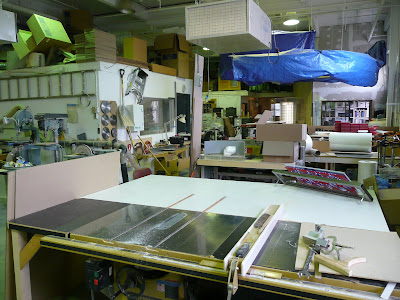
I teach a design history class, so I spend a lot of time in Google image search, looking for historic images of buildings and interiors to illustrate the lecture. Amongst the images that have been coming up recently were what looked like perfectly detailed models of some of these places. In fact, they were examples of a recently budding trend known as tilt shift photography. This process uses a special lens or digital manipulation to make an image of a real place look like a model. A small and narrow depth of field and a significant amount of blurring give the image the qualities of a close up photograph of a scale model. Seeing the world as a model is somehow fascinating.
As designers we model space in many ways, through orthographic projections, perspectival views, and, as programs become more powerful and sophisticated, fully realized digital models of the designed environment. One can develop a virtual 3D model in Sketch Up or Revit rapidly, manipulate it in space, fly through the interior and move the entire assembly through space and time to study the effects of the sun. However, the reality being represented is cinematic in nature, our experience of it is directed and we still see it only as images, moving or not, on a flat screen. No matter how well developed and powerfully rendered, there is still a sense of disconnectedness for the viewer. While we can create a model that mimics the way the designed space will look, it in no way is like being in a real place or space.
A physical model allows a different sort of occupation, one that requires some effort. However, that effort increases our level of engagement with the space, allowing a greater sense of occupation. Rather than being shown how the space may look, we must imagine ourselves at scale, moving through the space. While this is certainly true for designers, (“Models are like flypaper for architects”) I believe it is true for almost everyone.
 Here they make models ranging from the highly finished, illuminated models used as sales tools to study models in multiple iterations. Designers can order a kit of parts and use the models as a design tool. Feyereisen Studios recently completed a model of the Stillwater Lift Bridge designed as a study aid for the visually impaired.
Here they make models ranging from the highly finished, illuminated models used as sales tools to study models in multiple iterations. Designers can order a kit of parts and use the models as a design tool. Feyereisen Studios recently completed a model of the Stillwater Lift Bridge designed as a study aid for the visually impaired. As some of you may know (and as may become apparent through these missives) I am a bit of a Luddite. It may have something to do with my seeming ability to make nearly any computer program freeze and crash, but I think is also based on my love of manipulation of the material world. As a designer, I feel a sense of unease -- if not loss -- with the continued movement into a digital and virtual world. I feel strongly that we need to keep building and studying physical models as we design, as a way to test what we have drawn, but also as a way to keep a physical connection to the process of design, moving our hands and minds.
As some of you may know (and as may become apparent through these missives) I am a bit of a Luddite. It may have something to do with my seeming ability to make nearly any computer program freeze and crash, but I think is also based on my love of manipulation of the material world. As a designer, I feel a sense of unease -- if not loss -- with the continued movement into a digital and virtual world. I feel strongly that we need to keep building and studying physical models as we design, as a way to test what we have drawn, but also as a way to keep a physical connection to the process of design, moving our hands and minds.
Bricks from the Kiln—Issue 2: Andrew Lister & Matthew Stuart in
conversation with Paul Bailey
-
BFTK #2 cover This past March, Andrew Lister and Matthew Stuart released
issue #2 of their multifarious journal, Bricks from the Kiln (BFTK). As a
journa...
8 years ago


3 comments:
If only those tilt-shift lenses weren't so dang expensive!
What about all the models made via lasers, rapid prototyping and other digital to material methods. If used properly can't the digital actually facilitate making more readily than X-acto blades and Elmer's glue?
Colin
Certainly digital production techniques will make things faster, easier and more accurate, and are a great tool. One aspect of the argument is that doing something by hand, where one must physically manipulate material engenders a different awareness of the space being represented; a similar argument can be made for hand drawing vs. CAD drawings. The physical assembly of hand made parts is instructive to how the assembly of the building being modeled. Part of my interest in this is the joy I feel in seeing hand built models that is lacking in the experience of computer generated imagery or forms. This is a discussion worthy of more space than this forum, perhaps it is time for an analog vs. digital showdown/forum/fest.
Tom
Post a Comment